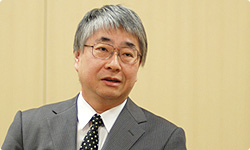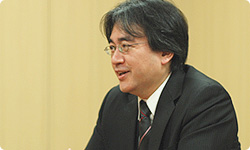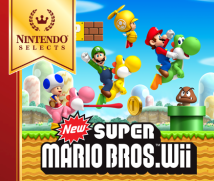4. Adjusting the Map in a Daily Cycle
Let’s return to Super Mario Bros. at this point. Could you tell us about anything from the start of the development process that left a particularly strong impression on you?
I can clearly remember right at the start of the development process when the blue sky appeared on the screen.
Games at that point almost always had black backgrounds, didn’t they?
That’s right. At that time, there was nothing displayed on the screen aside from the blue sky with white clouds and the ground but that image really jumped out of the screen and I thought: “This is incredible!”
You’d never seen anything like it before?
Right. I'd never seen anything like it. When I saw that image, it was already late in the evening but I rang Miyamoto-san straight away, telling him: “We've come up with something amazing!” (laughs)
(laughs)
Even I was really surprised at the time that the Famicom could manage to display such vivid graphics.
So with that screen as your base, you went on to create the maps, right?
That’s right. Miyamoto-san said to me right at the start: “Make it so that a single level lasts about one minute.” But with a regular game, you could run across a single screen in about one second.
If it takes a second to run across the screen, and you want it to last for a minute, you’re going to need sixty screens.
That's why I asked: “Are we really going to make this many screens? ” Miyamoto-san responded by saying: “We’re going to have all sorts of things going on in between, so twenty screens should be enough for a single level.” At that time, I couldn’t grasp what Miyamoto-san meant.

I’d imagine that although the screen at that time only had blue sky, clouds and the ground, Miyamoto-san already had lots of concrete images in mind.
Yes, I think that’s right. We didn't even use twenty screens in the end.
When we came to actually create the levels, we’d only need about twelve screens.
Yes, that’s about right.
Even the longest level, which we put all of our energy into, only totalled thirty-two screens. There was only one level like that: all of the others were fine being shorter.
I see.
And even though Miyamoto-san didn’t have any level plans, he could envisage what was ahead. I was truly astonished when I saw him stating what we’d need to do next with absolute confidence.
How did you go about creating the levels?
The data for the levels was entered manually. We'd sketch a design for the level on a piece of paper then pass it on to SDR, saying: "Please make it look like this."
Tezuka-san or Miyamoto-san would draw the level on a huge sheet of graph paper and we would have to painstakingly enter the data by hand.
So it was very time-consuming.
And if the map was modified, it would create a real headache.
Yes, it really would. Every morning when I got to work, I’d be handed about twenty sheets of paper and be told to get on with it.
And you’d get notes saying things like: “Please modify the map like this."
Yes, those instructions would be written on with pencil. We’d spend the entire day poring over these notes and adjusting the map. Then at around ten at night when we’d finally finished, we’d burn the data to the ROM, at which point the two of them would play the level. Then if there were any changes, I'd receive them in the morning. This process was repeated over and over again.
So there was a daily cycle going on.
We just about managed to make the adjustments in a one-day cycle. Compared to that, the way things are done now is paradise. We can now modify the levels ten or twenty times in a single day.
With the way you make levels now, you can request that something be moved slightly, then see it being done right in front of your eyes. Then you can give it a try and play the level right away.
To do that would have once taken a whole day.
That reminds me - I once heard that when you create the levels in Super Mario, you don’t actually start from the first screen.

That’s right. We might come up with World 3 or World 5 first of all. Those will be the most fun. But although they’re fun, when we got beginners to try them out, they’d prove to be incredibly difficult. At that point, our basic principle is to move easier features to the beginning of the level.
I think most people would assume that you’d generally start from the first screen and work from there. But that’s actually not the case at all. This is something we spoke about in the last Iwata Asks interview, but I thought that the level design for the start of World 1-1 was really superb.
Ah, you’re talking about the way it’s designed so that the player will always get the mushroom.
That’s right. I was incredibly impressed when I first became aware of this, and though it had nothing to do with me, I’ve gone around boasting about it to plenty of people! (laughs) Whenever anyone finds out that this level was designed with that very deliberate purpose in mind, they’re always really impressed. How did that level first come about?
It was largely worked out on paper. We’d start off with a rough outline of the layout and then Miyamoto-san would have firm ideas: “You’re going to come at it from here. And you'll do something here…"
So you’d simulate the process of playing through the level on paper, thinking that if the player was here, they’d want to do this or that next.
That’s it.
And we’d try to think through the various alternative outcomes. For instance, we might say that normally a player would get the mushroom, but just in case they fail to do that, we’ll get them to pick it up this way.
That’s the reason you positioned the first pipe where you did.
Right, because when the mushroom hits the pipe, it bounces back. Even right at the start of World 1-1, all of the elements of Super Mario were present and correct.
So level 1-1 was made towards the end of the development?
Yes, it was. I’m absolutely sure we created that level at the end. And World 1-1 was also the level that we were still adjusting right up until the last minute.
At the time the game was released, there were no strategy guides available. When the player started the game for the first time, they tended not to read the instruction manual, and there was no one who was going to tell them what to do. Everyone was a beginner when it came to Super Mario, so you designed the game with a particular awareness that this sort of player should become familiar with the way things worked in this world and become absorbed in it in a natural way.
Right, we were extremely conscious of that.
In particular, on World 1-1.
And it was no doubt because of this that so many players responded so positively to Super Mario.
